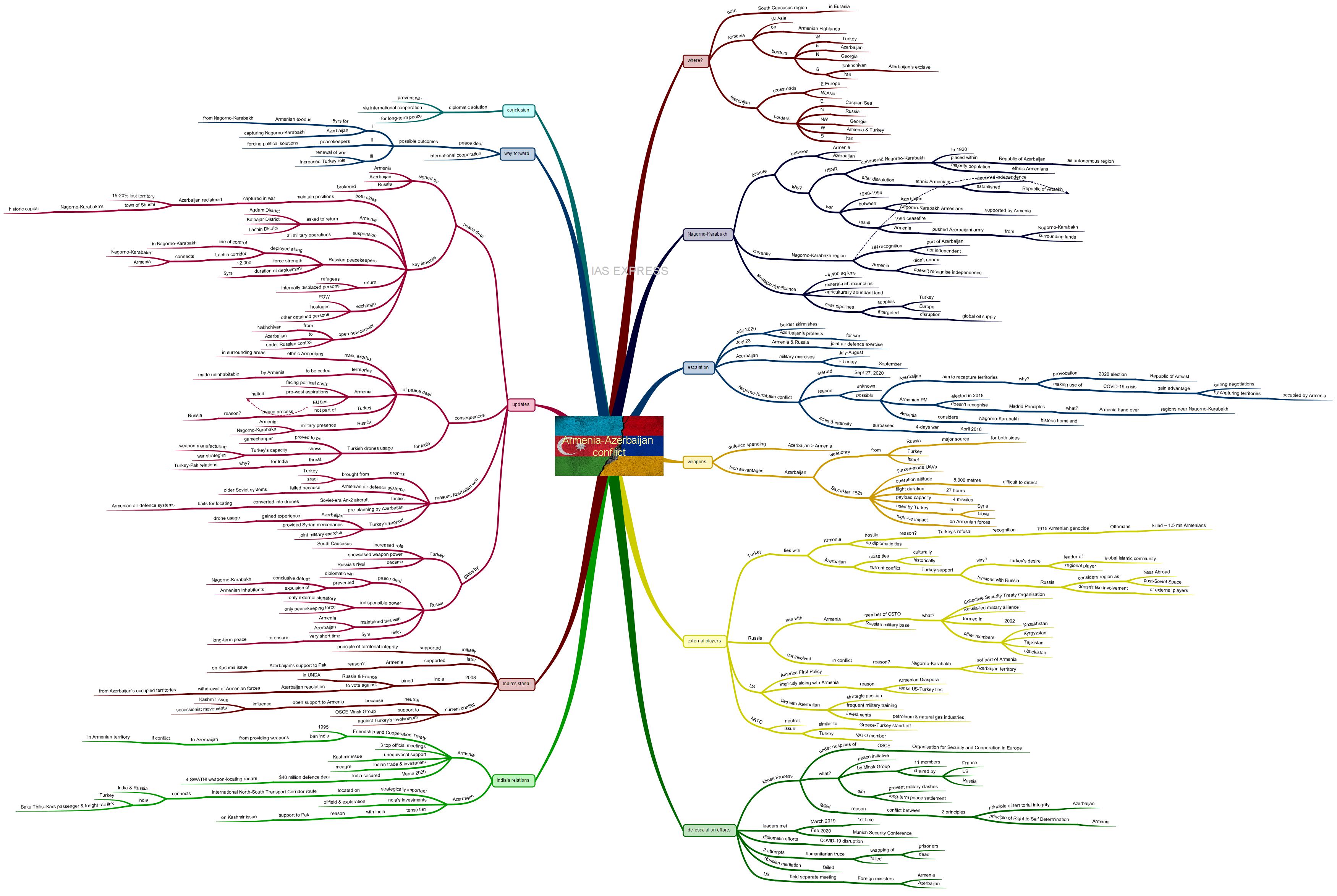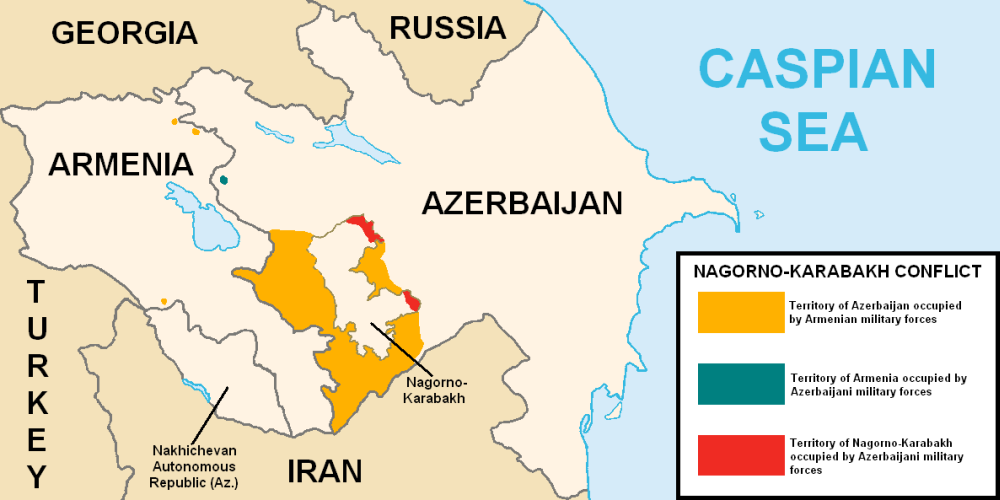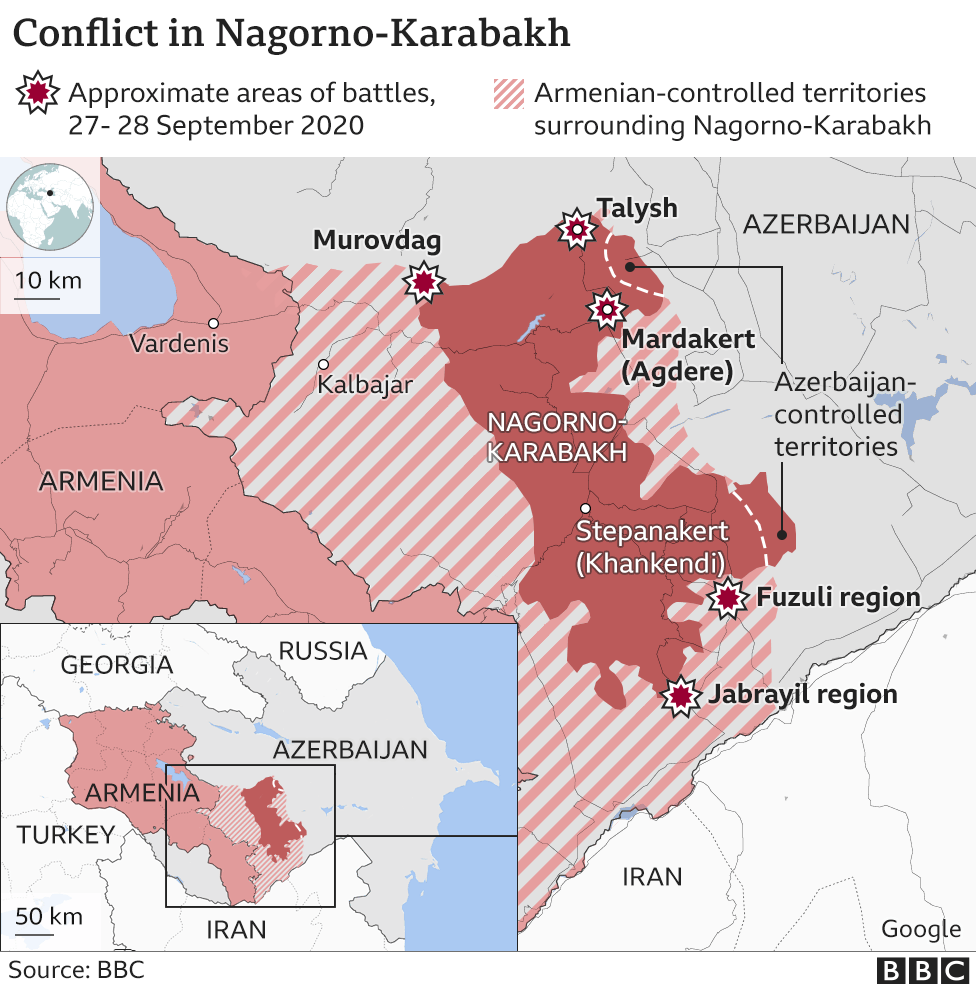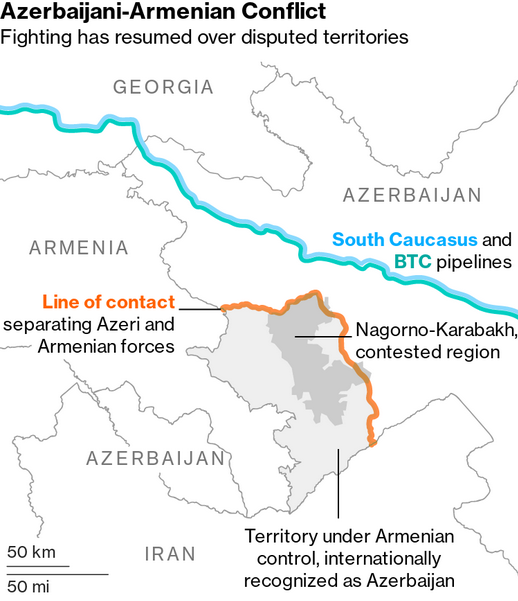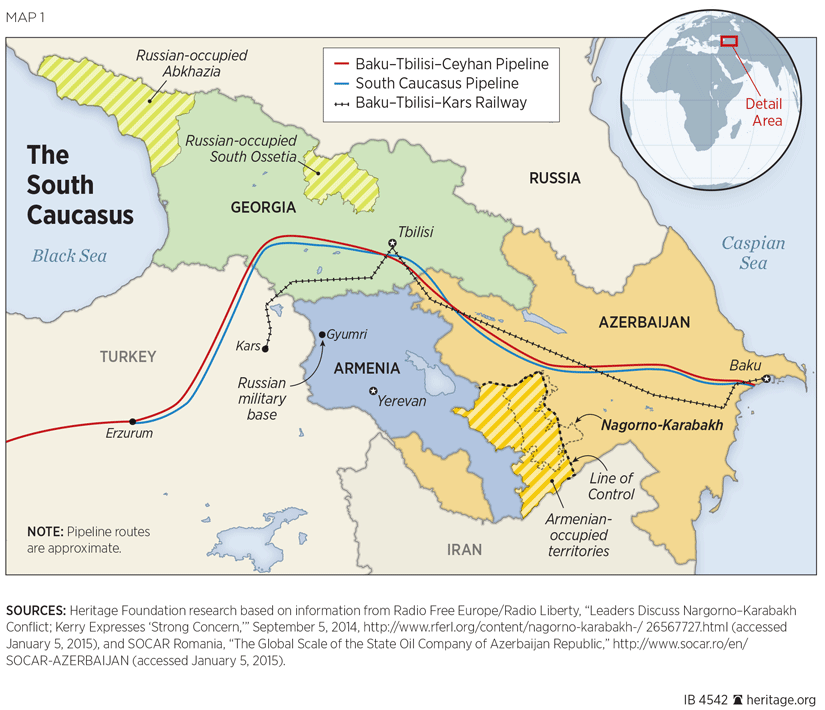[Updated] Armenia-Azerbaijan Conflict – All You Need to Know
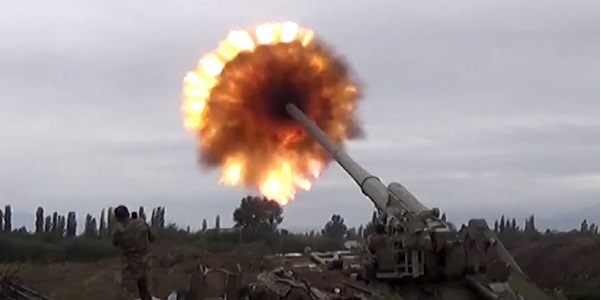
From Current Affairs Notes for UPSC » Editorials & In-depths » This topic
IAS EXPRESS Vs UPSC Prelims 2024: 85+ questions reflected
The 6-week war in Nagorno-Karabakh has been brought to an end following the signing of the peace agreement brokered by Russia. After the signing of this pact, it is evident that Azerbaijan is the clear winner as Armenia was forced to concede several of its territories to its rival. Two other countries became unlikely victors in this conflict – Russia and Turkey. Both these countries have ensured that they had a key role to play in this conflict, leading to their presence growing in South Caucasus.
Where are Armenia and Azerbaijan?
- Armenia and Azerbaijan are countries located in the South Caucasus region of Eurasia.
- Armenia is located in Western Asia, on the Armenian Highlands. It is bordered by Turkey to the west, Georgia to the north and Azerbaijan to the east and Iran and Azerbaijan’s exclave of Nakhchivan to the south.
- Azerbaijan is located at the crossroads of Eastern Europe and Western Asia. It is bounded by the Caspian Sea to the east, Russia to the north, Georgia to the northwest, Armenia and Turkey to the west and Iran to the south.
Why is there a dispute over the Nagorno-Karabakh region?
- Christian-majority Armenia and Muslim-majority Azerbaijan have been belligerent towards each other for centuries.
- The countries’ religious difference has little to do with the decades-long conflict.
- The main cause for the conflict is because of the dispute over Nagorno-Karabakh (Armenians call it Artsakh).
- After conquering the region in the 1920s, the USSR placed the enclave as an autonomous entity under within the Republic of Azerbaijan.
- The majority of the population in this mountainous region is ethnic Armenians.
- When the USSR began to collapse in the late 1980s, this region became the main cause of contention between the two former Soviet Republics (Armenia and Azerbaijan).
- Following the dissolution of the USSR, the disputed region’s ethnic Armenians declared independence, resulting in the establishment of the Republic of Artsakh.
- This led to a war (1988-1994) between Azerbaijan and Nagorno-Karabakh Armenians, who received financial and military support from Armenia.
- The Armenians succeeded in pushing the Azerbaijani army from the enclave and large surrounding swaths of land.
- The 1994 ceasefire has failed to bring in long-term peace, leading to periodic clashes breaking out over the past years, which resulted in hundreds being displaced or dead.
- Now, the UN still recognises the Nagorno-Karabakh region to be a part of Azerbaijan’s territory and not an independent entity.
- Even Armenia does not recognise the enclave as an independent country, though it has not formally annexed it.
Why is the conflict escalating?
- Border skirmishes between Armenia and Azerbaijan occurred in July 2020, which resulted in demonstrations by Azerbaijanis in support of the war against Armenia.
- Armenia, on 23rd July 2020, announced the start of a joint air defence system exercise with Russia and an analysis of the July 2020 clashes.
- Azerbaijan also conducted a series of military exercises between July and August and another exercise involving Turkey in September.
- According to Artsakh authorities, the current conflict over Nagorno-Karabakh commenced on 27th September 2020.
- However, the catalyst behind the on-going clashes is still unclear, with both sides blaming each other.
- The possible reasons for the conflict over the Nagorno-Karabakh region are as follows:
- Azerbaijan making use of COVID-19 crisis to recapture swathes of territories occupied by Armenian forces in 1988-94 war and gain upper hand during the negotiation process
- Domestic politics and diplomatic frustrations
- 2020 elections held by the self-declared Armenian government in Karabakh. The election provoked Azerbaijan and led to international criticism.
- Armenian Prime Minister Nikol Pashinyan, who came to power in 2018, does not recognise Madrid Principles, which calls on Armenia to hand over the areas around Nagorno-Karabakh back to Azerbaijan.
- Armenians’ consideration of Nagorno-Karabakh as part of their historic homeland
- Both sides are currently involved in a series of rhetoric with little consideration to peace and stability.
- While Azerbaijan justified its military aggression with the need to counter Armenia’s combat activity, Armenia accused Azerbaijan of attacking civilian settlements in Nagorno-Karabakh region.
- Azerbaijan claimed that its military aggression was aimed at taking over the areas that are legally its territory occupied by enemy troops and separatists for decades.
- Turkey has backed this stance.
- In terms of its scale and intensity, this current conflict has surpassed all previous clashes, including the “Four Days War” of April 2016.
Why is Nagorno-Karabakh strategically important?
- Nagorno-Karabakh, which is around 4,400 square kilometres, consists of several small, fast-flowing rivers cutting several deep ravines through mineral-rich mountainous terrain on their way to a central valley.
- This has resulted in the rugged, yet agriculturally abundant land with black soil.
- The disputed region lies close to westward oil and gas pipelines.
- The energy-rich Azerbaijan has built these pipelines across the Caucasus (the region between the Black Sea and the Caspian Sea) to supply to Turkey and Europe.
- If the conflict escalates, these pipelines could be targeted, creating an impact on global energy supplies.
What are the weapons used in this war?
- The on-going conventional war over Nagorno-Karabakh involves the participation of professional armed forces and the use of hi-tech 21st-century weaponry, which has the capacity to make this conflict more destructive than ever before.
- Azerbaijan’s excessive defence spending over the past years has dwarfed Armenia’s weapons.
- Thus, Azerbaijan has technological advantages, especially with its combat drones purchased from Israel and Turkey.
- However, whether the destructive powers of these weapons will prove to be the decisive factor in the current conflict is yet to be established.
- Azerbaijan is currently using Bayraktar TB2s, unmanned aerial vehicles manufactured in Turkey.
- TB2s can operate at an altitude of 8,000 metres, making them difficult to detect.
- They can also fly up to 27 hours with a payload of four missiles
- They have been used in Syria and Libya by the Turkish air force.
- They are currently being used in Nagorno-Karabakh against the separatist regime.
- The use of these UAVs has significantly affected the Armenian forces on the ground and their ability to reinforce and defend themselves.
- Most of Azerbaijan’s weapons have come from Russia, Israel and Turkey.
- While Russia is the major source of weaponry for both sides, Moscow has realised that Israeli and Turkish drones and missiles risk outperforming Armenia’s often out-dated hardware.
- Russia, after grasping this flaw, started equipping Armenia with whatever weapons that were sold to Azerbaijan.
What is the role of external players?
Turkey:
- Historically, Turkey has remained a strong supporter of Azerbaijan while maintaining a tense relationship with Armenia.
- During the 1990s war between Armenia and Azerbaijan, Turkey closed its border with Armenia
- Turkey has no diplomatic ties with Armenia.
- The main reason behind the antagonism is Turkey’s refusal to recognise the 1915 Armenian genocide in which Ottomans killed over 1.5 million Armenians.
- In contrast, Azerbaijanis and Turkish people share close cultural and historical ties.
- Following the clashes in July 2020, Turkey and Azerbaijan held a joint military exercise.
- Furthermore, in September, Ankara blamed Armenia for the most recent clashes and offered support to Azerbaijan.
- Armenia accused Turkey of blocking flights carrying emergency aid from using its airspace.
- Ankara’s current pro-active role in this dispute is because of its desire to emerge as a leader of the global Islamic community and also as a regional player.
- This stance may create tension between Turkey and Russia, as the latter considers the region as part of its ‘Near Abroad’ and post-Soviet Space and does not tolerate any involvement by other countries
Russia:
- Russia enjoys close ties with both Armenia and Azerbaijan.
- However, Armenia is more dependent on Moscow than the oil-rich and ambitious Azerbaijan.
- Furthermore, Armenia is a member of the Russia-led military alliance, the Collective Security Treaty Organisation (CSTO) signed in 2002.
- The other members of this grouping include Kazakhstan, Kyrgyzstan, Tajikistan and Uzbekistan.
- Russia also has a military base in Armenia.
- Regardless of having close defence ties with Armenia, Moscow stated that the CSTO does not apply to the Armenian-occupied Nagorno-Karabakh region, which is Azerbaijan’s territory.
- Moscow is of the view that it can provide military assistance to CSTO member only when the external aggression takes place within the territory and not outside (in Nagorno-Karabakh).
- Thus, it has refused to send in troops to assist Armenia.
- The Trump Administration’s “America First” diplomacy has led to the US playing a minimal role in the on-going conflict.
- The US government, however, appears to be siding with Armenia.
- This may be because Armenia has a sizable and mobilized diaspora community in the US.
- In the early 1990s, this community succeeded blocking the US aid to Azerbaijan.
- The US also maintains a close relationship with Azerbaijan because of its strategic position.
- The US troops frequently train in the country.
- Azerbaijan is one of the first countries to allow coalition forces to fly through its airspace as part of the war on terrorism.
- Furthermore, western corporations are deeply invested in Azerbaijan’s petroleum and natural gas industries.
- However, close US-Azerbaijani ties seem unrealistic in current times given the deteriorating relationship between the US and Turkey.
NATO:
- NATO has officially stepped aside from this conflict, stating that both the warring countries have been its valued partners for more than two decades.
- It had called for restraint and de-escalation of the conflict.
- The current position of NATO presents evidence of its inability to stay united during the times of crisis.
- The on-going conflict between Armenia and Azerbaijan could only lead to the further disintegration of the grouping.
- Yet again, this conflict (like the on-going Greece-Turkey stand-off) at NATO’s backyard positions Ankara against much of the Western European countries.
What are efforts taken to deescalate the tensions?
- After the 1994 ceasefire, an international peace initiative known as the Minsk Process, under the auspices of the Organisation for Security and Cooperation in Europe (OSCE), has tried and failed to end the Nagorno-Karabakh dispute.
- The reason for the failure is that the conflict is more than an ethno-territorial conflict.
- The dispute is a conflict between two principles:
- The principle of territorial integrity (Azerbaijan and allies)
- The principle of Right to Self Determination (Nagorno-Karabakh and Armenia)
- The 11-member Minsk Group, chaired by France, Russia and the US, aimed to prevent military clashes and implement a long-term peace settlement in the region.
- This group, which is supposed to be neutral, is often criticised for its bias towards Armenia. This may be because of the existence of large and organised Armenian diasporas in France, the US and Russia.
- On March 2019, Armenian Prime Minister and Azerbaijani President met formally for the first time and later on February 2020 for a public debate at the Munich Security Conference.
- The COVID-19 pandemic has later disrupted the diplomatic efforts from earlier this year.
- On 1st October, the Minsk Group called for a ceasefire, which was rebuffed by Turkish President Erdogan.
- So far, there have been two attempts at a humanitarian truce that would allow prisoners and war dead to be swapped. Brokered by international mediators, these efforts have also failed.
- Russia’s effort on mediation saw little progress as both the warring countries blamed each other for the escalated tensions.
- On October 23, the US held talks with the foreign ministers of Azerbaijan and Armenia separately in a fresh attempt to end nearly a month-long bloodshed over Nagorno-Karabakh amid a handful of protests from both sides.
- Hours before these talks initiated in Washington DC, Azerbaijani and ethnic Armenian forces clashed again in several areas, including territories close to the line of contact.
India:
What is India’s relationship with Armenia and Azerbaijan?
India does not have a specific foreign policy focusing on South Caucasus like ‘Neighbourhood First’, ‘Act East’ or ‘Central Asia Connect’ policies. For New Delhi, this region remains only on the periphery of its radar. However, it should be noted that it has an asymmetrical relationship with the two disputing countries.
India-Armenia relations:
- India recognised the Republic of Armenia in 1991 after it disintegrated from the USSR.
- It is the only country in the region with which India has a Friendship and Cooperation Treaty, which was signed in 1995.
- This treaty prohibits India from providing military or any other assistance to Azerbaijan in case Azerbaijan’s military aggression in Nagorno-Karabakh spills over to the territory of Armenia.
- India has received three heads of states from Armenia but none from Azerbaijan.
- Armenia extends unequivocal support to India on Kashmir issue unlike Azerbaijan, which supports and promotes Pakistan’s narrative on the same.
- India’s trade and investments with Armenia are meager.
- In March 2020, India secured a $40 million defence deal with Armenia for supplying four SWATHI weapon-locating radars.
- However, it remains neutral with regards to the current conflict because of the fear of diplomatic repercussions on the Kashmir issue.
India-Azerbaijan:
- Azerbaijan is of strategic importance for India.
- This is because of its location on International North-South Transport Corridor route, connecting India with Russia through Central Asia.
- This route also connects India with Turkey and Baku Tbilisi-Kars passenger and freight rail link.
- India has relatively small investments in oilfield and exploration projects in Azerbaijan.
- Notwithstanding these interests, India is unlikely to back Azerbaijan.
- This is because, though Azerbaijan has built the case for the need to support the territorial integrity, it does not back India with regards to the Kashmir issue, which involves Pakistan violating India’s territorial integrity.
What is India’s stance on this on-going conflict?
- India has adjusted its stance on Nagorno-Karabakh conflict as the situation evolved over the past years.
- During the initial stages of the 1993 conflict, New Delhi endorsed the principle of respect for territorial integrity.
- Later, this position changed because of Azerbaijan’s open support to Pakistan on the Kashmir issue.
- In 2008, India joined Russia, the US and France to vote against Azerbaijan’s resolution in the UNGA that inter-alia demanded “immediate, complete and unconditional withdrawal of all Armenian forces from all occupied territories of Azerbaijan”
- Though India has relatively close diplomatic relationship with Armenia, a public endorsement would be difficult.
- If India openly backs Nagorno-Karabakh’s right to self-determination, its adversaries might misuse this stance by erroneously applying the same to Kashmir, which may even re-ignite secessionist movements in certain parts of India.
- In consideration of these issues, New Delhi has adopted a balanced and neutral stance by calling for restraint and the peaceful resolution of the conflict through diplomatic means.
- India has expressed its support for the OSCE Minsk Group’s continued efforts towards peace.
- This means that India is against the involvement of any other entity, including Turkey.
Update:
What is the peace deal between Armenia and Azerbaijan?
- On 10th November, Russia brokered a new peace deal between the two warring countries, putting an end to the military conflict that lasted for 6 weeks over the disputed region of Nagorno-Karabakh.
- According to the new peace deal, both sides will now maintain positions in the areas that they currently hold.
- This means that Azerbaijan gains a considerable advantage as it has reclaimed over 15 to 20% of its lost territory during the recent conflict.
- This includes the town of Shusha, known by Armenians as Shushi, the historical capital of Nagorno-Karabakh located at the centre of the disputed region. Shusha is located at just 16 km from Nagorno-Karabakh’s capital Stepanakert.
- Armenia was also asked to return the Agdam District, Kalbajar District and Lachin District within the deadlines set in the agreement. These districts were captured by Armenia during the 1990s conflict.
- Furthermore, under this peace pact, all military operations are suspended and the Russian peacekeepers will be deployed along the line of contact in Nagorno-Karabakh and along the Lachin corridor, which connects the region to Armenia.
- These Russian peacekeepers with a force of approximately 2,000 will be deployed in the said areas for the next 5 years.
- Currently, the peacekeeping force has set up checkpoints and positions in the region’s administrative centre to implement the accord that sees Armenia cede the swaths of territory Azerbaijan gained in the fighting.
- Refugees and internally displaced persons were told to return to the region and the adjacent territories.
- The two sides will also exchange prisoners of wars, hostages, other detained persons and dead bodies.
- Under this peace deal, a new corridor will be opened from Nakhchivan to Azerbaijan. This corridor will be controlled by Russia.
What are the consequences of the peace deal between the two countries?
- This conflict is considered to be one of the most serious in recent years.
- According to the Nagorno-Karabakh authorities, around 1200 people have died and thousands have been displaced.
- Ethnic Armenians living in the surrounding areas of Nagorno-Karabakh are undertaking mass exodus.
- The peace deal, while ensuring ceasefire has only aggravated ethnic animosity.
- Territories that are to be ceded by Armenia are being destroyed to make habitation as difficult as possible.
- While Armenia conceded that more than 2,000 fighters were killed in the recent clashes, Azerbaijan is yet to reveal its military casualties.
- Armenia’s government is facing a political crisis because of the peace deal.
- Turkey has failed to get involved in the peace settlement due to the push back from Russia.
- With Moscow already having a military base in Armenia and the arrival of Russian peacekeepers in Nagorno-Karabakh, Armenia cannot bring forth the issue of withdrawal of Russian troops for the foreseeable future.
- This puts an end the pro-West aspiration of Armenia, which has sought closer economic and political ties with the European Union.
- Notably, the Armenian government had signed a free-trade deal and an association agreement with the EU in 2013. This was seen as the first step towards political integration with the bloc.
- It had later pulled out of these deals to join the Eurasian Economic Union – a Moscow-dominated bloc of ex-Soviet nations.
How did Azerbaijan win the war?
The recent war between Armenia and Azerbaijan ended with the latter gaining most the territories. This has decisively turned the tables to Azerbaijan’s advantage, a stark contrast to the 1990s war when Armenia took control of portions of Azerbaijan’s territory. The factors contributing to this are as follows:
Drone power:
- Azerbaijan had a considerable advantage over Armenia because of the presence of drones.
- It used its drone fleet purchased from Israel and Turkey to stalk and destroy Armenia’s weapon systems in Nagorno-Karabakh.
- This led to the destruction of Armenia’s defences, which then resulted in Azerbaijan advancing to key positions with considerable ease.
- These attacks led to around a third of Armenian tanks being destroyed, forcing Armenia to concede defeat.
- In the early stages of the war, Azerbaijan used slow Soviet-era An-2 aircraft that has been converted into drones.
- These were used as bait to Armenian air defence systems – tempting them to fire and reveal their positions.
- Later, this information was used to destroy almost the entire air defence systems of Armenia.
- Surveillance drones were also used to spot targets.
- Armenia’s air defence systems failed in this conflict because many of them were older Soviet systems with little to no capacity to defend against drone attacks.
Pre-planning:
- From various strategies used by Azerbaijan, it is evident that it has been preparing for this over a long time.
- It has decided to change the status quo due to its frustration with Armenia’s lack of interest in returning the occupied territories.
Turkey’s role:
- Turkey’s support for Azerbaijan is also one of the contributing factors for the victory.
- The two allies have been heavily coordinating the war efforts.
- Turkey was accused of moving Syrian mercenaries into Azerbaijan two weeks before the conflict.
- However, Turkey has denied these claims.
- Furthermore, Ankara participated in the joint military exercise with Azerbaijani forces.
- Azerbaijan has benefited from Turkey’s experience of its recent use of drones in Syria and Libya, where its drones overpowered the Russian-made Pantsir S1 air defence systems.
What are the gains obtained by Turkey and Russia from this conflict?
Both Turkey and Russia, though not directly involved in the recent conflict, have gained certain strategic advantages from the same.
Turkey:
- For Ankara, the recent war was a showcase of its growing role in the strategically important South Caucasus.
- This is because it played a huge part in Azerbaijan’s victory by providing weapons, training and support.
- Turkish officers were also said to have been involved in guiding drone attacks, which played a decisive role in this conflict.
- This has led to the growth of the Turkish influence in the region that was under the Russian influence for a long time.
Russia:
- The peace pact agreed by the two warring countries was brokered by Russia.
- This is a diplomatic win for Moscow.
- Russia refused to assist Armenia, its only treaty ally in the South Caucasus.
- This is because of Armenia’s tough stance on Nagorno-Karabakh and its apathy towards the peace process.
- When the Azeri military took control of Shusha, Russian diplomatic efforts intensified and a mixture of diplomacy and pressure was used to secure the peace deal.
- This deal prevented conclusive defeat of Nagorno-Karabakh and the likely expulsion of its Armenian inhabitants.
- With this pact, Russia became the only signatory of the peace deal beyond the leaders of the two warning states and the Russian troops will be only peacekeepers monitoring the implementation of the agreement, with no Turkish or any other forces on the ground.
- With this, Moscow was able to demonstrate that it remains an indispensable power in the region.
- This was done while preserving its relations with both Armenia and Azerbaijan and successfully competing with Turkey.
- However, this diplomatic win comes at a price.
- This war has shown Turkey’s growing influence in the region – reducing Moscow’s dominant position as being the only major power in the region.
- The major risk for Russia is this truce is only a temporary solution, as the presence of Russian peacekeepers will expire in five years, after which both the disputing countries will be in a position to call for their withdrawal.
- This is a very short time to ensure the long-term peace in the region, given the shattered status quo has made the possibility of peace between the two sides a challenging endeavour.
- To achieve long-lasting peace, Russia would require assistance from the US and Europe, which were completely absent from the picture this time around.
How does Turkey’s growing influence affect India?
- Drones, which were used to defeat Armenia, were brought from Turkey.
- Designed by Turkey, these drones were infamous for their role in conflicts in Syria and Libya and now in the recent conflict in South Caucasus
- This proves that Turkey is perfectly capable of building its own drones and creating sound war strategies.
- With Ankara having close ties with Pakistan, there is a high possibility of these deadly drones being used against India.
- There is also the possibility of Turkey helping Pakistan to further its antagonism against India.
What is the way ahead?
- The peace deal brokered by Russia has brought in little scope for de-escalation of ethnic tensions between Armenia and Azerbaijan.
- Both warning countries are now perhaps as far away from peace as they have ever been.
- Many questions remain unanswered by this peace agreement.
- For instance, it failed to address Nagorno-Karabakh’s final status.
- The five-year period when Russian peacekeeping force is deployed will essentially serve as a period for local Armenians to vacate on their own before Azerbaijan takes over Nagorno-Karabakh.
- However, at the same time, the presence of peacekeepers would provide an edge for Nagorno-Karabakh, whose territory has an unclear status.
- It would force Azerbaijan to reach a political settlement instead of launching a renewed offensive.
- However, due to the agreement’s failure to solve anything other than ensuring peace and transit corridors, there is a high possibility of renewed war.
- Turkey’s vociferous role in this whole situation has only furthered the divide between the two belligerents.
- It would only try to increase its presence in the region, so as to compete with its rival, Russia.
- To address these problems, international cooperation, as well as political will, is required from various concerned players, including India.
Conclusion:
With the high possibility of another violent war breaking out this region in the near future, countries across the world must cooperate to ensure diplomatic solutions that would provide for long-lasting peace in the South Caucasus.
Practice question for mains:
The end of the war between Armenia and Azerbaijan has shifted the global power structure. Elucidate. (250 words)
If you like this post, please share your feedback in the comments section below so that we will upload more posts like this.
